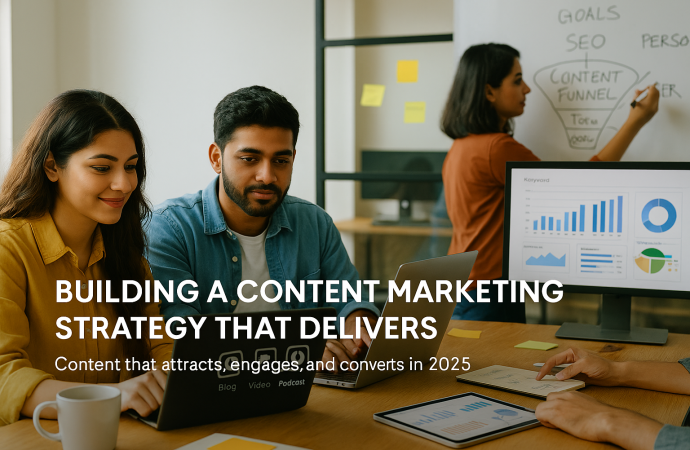Introduction In 2025, content is no longer just a tool for engagement it’s the cornerstone of building trust, authority, and customer loyalty. A well-executed content marketing strategy allows brands to speak directly to their audience’s pain points, answer their questions, and guide them seamlessly through the buyer journey. When executed correctly, a content marketing strategy
Introduction
In 2025, content is no longer just a tool for engagement it’s the cornerstone of building trust, authority, and customer loyalty. A well-executed content marketing strategy allows brands to speak directly to their audience’s pain points, answer their questions, and guide them seamlessly through the buyer journey.
When executed correctly, a content marketing strategy can significantly increase visibility, drive organic traffic, and generate leads without relying solely on paid advertising.
What is a Content Marketing Strategy?
A content marketing strategy is a structured approach to planning, creating, distributing, and measuring content with the goal of achieving specific business objectives. This can range from increasing brand awareness and building thought leadership to nurturing leads and driving conversions.
The strategy encompasses all content types blogs, videos, podcasts, infographics, newsletters, and more and is tailored to reach and resonate with your target audience at every stage of the funnel.
Why Content Marketing Strategy Matters More Than Ever
Step 1: Define Your Goals and Audience
Start with SMART goals Specific, Measurable, Achievable, Relevant, and Time-bound. For instance, do you aim to grow website traffic by 30%, generate 50 new leads per month, or improve customer retention by 10%?
Next, build detailed buyer personas. Understand who your audience is, their challenges, aspirations, and online behavior. Your content marketing strategy should revolve around providing real value to these personas, guiding them from awareness to decision-making.
Step 2: Audit Existing Content
Before producing new content, conduct a content audit. Review what’s already published on your website and social channels. Ask:
- Which pieces are performing well?
- What’s outdated or underperforming?
- Are there gaps in the content that align with user queries?
This step helps you repurpose existing content, remove irrelevant assets, and make informed decisions for future content planning.
Step 3: Choose the Right Content Types
Your strategy should include a mix of formats based on audience preferences:
- Blog Posts: Ideal for SEO and thought leadership.
- Videos: Boost engagement and storytelling.
- Infographics: Simplify complex data visually.
- Email Newsletters: Perfect for nurturing leads.
- Podcasts: Great for long-form, insightful content.
Using varied content types increases reach and caters to diverse learning styles, which keeps users engaged and returning.
Step 4: Create a Content Calendar
A content calendar helps you stay consistent and organized. It should outline:
- Topic titles
- Target persona
- Distribution platforms (e.g., blog, YouTube, LinkedIn)
- Publishing frequency and dates
Strategic timing around holidays, product launches, or awareness days can amplify visibility. More importantly, consistency builds trust with your audience.
Step 5: Optimize Content for SEO
A content marketing strategy must align with SEO best practices. This includes:
- Using keyword research tools to identify high-traffic search terms.
- Optimizing meta titles, descriptions, headers, and alt text.
- Structuring content with clear headings and internal links.
- Ensuring mobile-friendliness and fast load times.
Search-optimized content enhances discoverability, bringing in qualified traffic that converts over time.
Step 6: Distribute and Promote Your Content
Creating content is only half the battle distribution is key to reaching your audience. Share your content across:
- Social platforms (LinkedIn, Instagram, Twitter)
- Email marketing campaigns
- Online communities like Reddit or Quora
- Influencer collaborations and guest blogging
Don’t hesitate to use paid promotion for high-value content. Platforms like Meta or Google Ads can amplify reach and boost initial engagement.
Step 7: Track Performance and Refine Strategy
Your content marketing strategy must be data-driven. Use tools like Google Analytics, HubSpot, or Semrush to monitor KPIs:
- Organic traffic and keyword rankings
- Bounce rate and average session duration
- Lead generation and conversions
- Social shares and backlinks
Regular performance tracking helps you refine your strategy—doubling down on what works and pivoting where necessary.
Step 8: Align Content with the Customer Journey
An advanced content marketing strategy maps content types to different stages of the funnel:
- Top-of-funnel (Awareness): Educational blogs, social posts, infographics.
- Middle-of-funnel (Consideration): Case studies, comparison guides, webinars.
- Bottom-of-funnel (Decision): Testimonials, product demos, pricing pages.
Delivering the right content at the right stage nurtures leads more effectively and increases conversion potential.
Example: How a Digital Agency Uses Content Strategy
Consider a digital marketing agency like Mediaclans. Through a robust content marketing strategy, the agency can publish SEO-optimized blogs, trend reports, video explainers, and case studies to attract, engage, and convert leads.
By showcasing results-driven campaigns and offering valuable tips, Mediaclans positions itself as a credible authority, nurturing potential clients organically through each stage of the buying process.
Tools to Support Your Strategy
-
Content Planning: Trello, Asana, or CoSchedule.
- Keyword Research: SEMrush, Ahrefs, or Ubersuggest.
- SEO Optimization: Yoast SEO (WordPress) or Clearscope.
- Social Scheduling: Buffer, Hootsuite, or Sprout Social.
- Analytics: Google Analytics, HubSpot, or Moz.
The right tools streamline tasks and provide data for smarter decisions.
Overcoming Common Challenges
- Lack of Resources: Start small—focus on one channel and scale up.
- Time Constraints: Batch content creation and use templates.
- Measuring ROI: Track micro‑conversions like downloads and email sign‑ups.
- Keeping Content Fresh: Update evergreen articles and refresh facts regularly.
Addressing these hurdles head‑on keeps your strategy on track.
Final Thoughts: Content Is the Future of Growth
In a landscape crowded with information, content that solves real problems and educates wins. A thoughtful content marketing strategy isn’t just about publishing more it’s about publishing with purpose.
Focus on what matters to your audience, optimize it for search, distribute it where your audience spends time, and consistently track results. By doing this, you’ll create meaningful interactions, establish brand authority, and build customer loyalty in a sustainable and scalable way.
















